
Do bees self-medicate? An examination of the impacts of xenobiotics on anti-viral defenses in honeybees
Diana Cox-Foster, Ph.D., Professor, The Pennsylvania State University
Do viruses manipulate honey bee behavior in ways that increase their transmission?
Adam Dolezal, Ph.D., Postdoctoral Research Associate, Iowa State University
Assessing the impact of pesticides on honey bee health using a network of controlled, experimental hives
Scott McArt, Ph.D., Research Scientist, Cornell University
Investigating the effects of fumagillin and other common in-hive xenobiotics on immune function in honey bees
Rodney T. Richardson, Ph.D. Candidate, The Ohio State University
Sublethal effects of neonicotinoids (imidacloprid) on embryogenesis, hygienic behavior and grooming of worker honey bees
Elemir Simko, DVM, Professor, University of Saskatchewan
Elucidating the effects of real world pesticide load and diet variety on honey bee health
Dennis vanEngelsdorp, Ph.D., Assistant Professor, University of Maryland
Honey bee hemocyte profiles associated with winter hardiness
James B. Burritt, PhD, Associate Professor, University of Wisconsin-Stout
Exposure of honey bees to neonicotinoids in corn guttation fluid
Jonathan Lundgren, PhD, Adjunct Professor, South Dakota State University & Kristine Nemec, PhD, USDA-ARS
The effect of nutritional stress on the foraging and recruitment activity of honey bee workers
Heather Mattila, PhD, Knafel Assistant Professor, Wellesley College
How Do Drought Stress Related Alterations to Floral Traits and Reward Profiles in Canola Influence Honeybee Foraging and Colony Health?
Arathi Seshadri, PhD, Assistant professor, Colorado State University
Assessing the role of environmental conditions on efficacy rates of entomopathogenic nematodes for controlling small hive beetles in honey bee hives - a citizen science approach
Elizabeth Hill, President, Center for Urban Bee Research & Ashleigh Smythe, PhD, Assistant Professor, Virginia Military Institute
The effects of pollen diversity on bumble bee health in an agricultural environment
Anthony Vaudo, PhD Candidate, The Pennsylvania State University
Stimulating propolis collection to benefit honey bee health and immunity
Renata Borba (P.I.) and Dr. Marla Spivak; Department of Entomology, University of Minnesota
The goals of this research are to explore ways for beekeepers to encourage honey bee colonies to
deposit a propolis envelope within standard beekeeping equipment, and to quantify the benefit of this
natural propolis envelope to colony health and immune system functioning, particularly in early spring
in northern climates. If a heavy propolis envelope is a vital component to a healthy bee colony, we
can modify the equipment currently used for beekeepers and beekeeping practices nationwide. Such
modifications will encourage the bees' natural construction of a necessary antimicrobial protective
envelope in the nest cavity. A long-term outcome of this research is to promote honey bee health,
which will directly support local, regional and national beekeepers by having stronger colonies to
produce more honey.
Honey hydrogen peroxide: diet effects and use as a colony stress indicator
Dr. Berry Brosi (P.I.) and Lydia McCormick; Emory University and Dr. Keith Delaplane;
University of Georgia
It has been known for a half---century that honey bees add hydrogen peroxide (H202) to honey and
that H202 has a strong antibacterial effect arising from the oxygen free radicals that it produces.
While this mechanism in its role as a preservative food stores is well understood, it is also known that
all organisms are to some degree susceptible to oxygen free radical damage. In this project we built
from previously collected pilot data to explore the potential that honey H202 production may comprise
a generalized colony defense mechanism, beyond its role as a honey preservative. Our project had
two specific aims: 1) Investigate the effects of supplemental sugar feeding on honey H202, with a
particular emphasis on supporting H202 production 2) Investigate the potential for using honey H202
as an early---warning indicator of colony stress.
Comparative analysis of honey bee survival and immune response to co-
infections of IAPV and N. ceranae using quantitative mass spectrometry based
proteomics
Dr. Leonard J. Foster, Amanda Van Haga, and Sarah Natrasany; University of British Columbia
Using proteomic tools, our research was aimed at understanding honey bee immune responses to
both fungal and viral pathogens in an effort to develop novel integrated pest management based tools
including RNAi based gene silencing treatment systems as an alternative to antibiotics for the control
of honey bee pathogens. Specifically, we aimed to evaluate survival and host immune response in
honey bees infected with Israeli Acute Paralysis Virus (IAPV) and Nosema ceranae, both singly and
in combination. Our overall goals of the project are to:
|
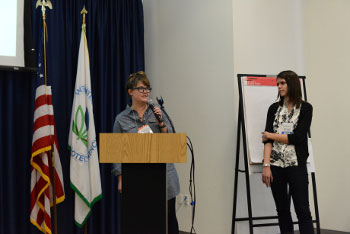 Amanda Van Haga and Sarah Natrasany of the University of British Columbia presenting at the 2012 NAPPC Conference at the U.S. Environmental Protection Agency |
Symbiont mediated pathogen protection
Dr. Lana Vojvodic; University of Arizona
This project has three ongoing components that are focused on the bacterial gut symbionts (probiotics) interaction with their honey bee host and the fungal pathogens that are known to cause chalkbrood and stonebrood disease. We test for the:
|
• Many flowering plants in fields before planting… effects on other pollinators?

The development of diagnostics or indicators for the presence of stressors that effect honey bee health, particularly those that can be used by beekeepers
Christopher Mayack; Colorado State University
Forager Energetic Stress as a Casual Mechanism for the Depopulation of Honeybee Colonies
Learn more by clicking here>>
Development of methods to improve genetic stocks of managed honey bee populations
Thomas Seeley, Delaney, Deborah and Tary; David Cornell University
Genetic evaluation of a survivor stock in the northeastern United States: the honey bees of the Arnot Forest
Effects of climate or environmental variables on: a) plants, especially nectar and pollen quantity and quality; and/or b) honey bee physiology and/or colony health
Martha Lopezaraiza Mikel with Quesada Avendano; Mauricio Universidad Nacional Autonoma de Mexico
Assessing floral resources availability in the tropical dry forest and agricultural sites of the Pacific Coast of Jalisco, Mexico to promote honey bee colony maintenance and health.
2010 Honey Bee Health Research Projects
Sublethal Doses of the Pesticide Imidacloprid Alters Honey Bee (Apis mellifera) Response Threshold and Optic Flow, Potentially Affecting Colony Health 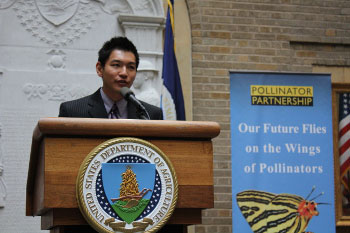 Dr. James Nieh of University of California, San Diego presenting
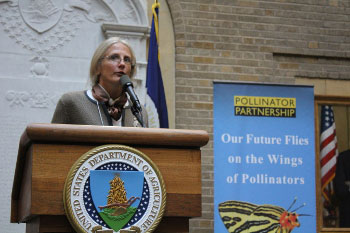 Josephine Johnson of the University of Maryland presenting
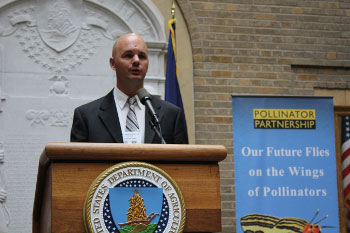 Dr. Mark Carroll of USDA-ARS, Carl Hayden Bee Research Center
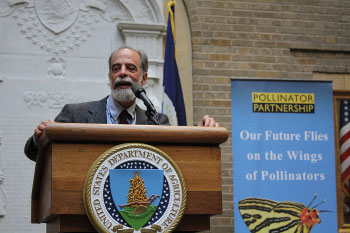 Dr. José Villa of USDA, ARS Honey Bee Breeding Laboratory |
2009 Honey Bee Health Research Projects
Food and fungi: The combined effects of food supplementation and Varroa mite control on honey bee health
Laura Burkle; Department of Biology, Washington University in St. Louis
The effects of pesticides on immature honey bee (Apis mellifera) development
Dr. James D. Ellis; Department of Entomology and Nematology, University of Florida
Genes over expressed in Varroa resistant honey bee strains: a novel tool to identify and select enhanced Varroa resistant honey bees
Dr. J. Spencer Johnston (P.I.); Department of Entomology, Texas A&M University, Jay D. Evans & Jeffery S. Pettis; United States Department of Agriculture, and Danny Weaver; BeeWeaver Apiaries Navasota
Designing a field test to estimate the nutritional status of honey bee colonies in the field and evaluating effects of pollen quality on honey bee physiology and behavior
Dr. Ramesh Sagili; Department of Horticulture, Oregon State University
The benefits of Propolis to the immune system of honey bees: do bees self-medicate?
Dr. Marla Spivak; Department of Entomology, University of Minnesota
Sublethal effects of pesticide combinations on honey bee (Apis mellifera L.) larval development and adult associative learning
Dr. James L. Frazier and Daniel R. Schmehl (P.I.s) with Maryann T. Frazier and Dr. Christopher A. Mullin; Department of Entomology, Pennsylvania State University
Health effects of Israeli Acute Paralysis Virus (IAPV) on native pollinators
Dr. Edwin J. Rajotte (P.I.), Rajwinder Singh, and Dr. Diana Cox-Foster; Department of Entomology, Pennsylvania State University
2008 Honey Bee Health Research Projects
Effects of miticide and Fumagilin-B® on honey bee survivorship and immune responses
Catherine M Little, M.Sc. candidate; Acadia University
Western honey bees (Apis mellifera) are exposed to a number of parasites. Varroa destructor, Nosema apis, and N. ceranae have particularly detrimental effects on colony productivity and survival. We will measure honey bee immune responses to infection by each of these three species of parasites and the effects of co-infection. We will then compare the results of infection with the effects of miticide and Fumagilin-B® use on honey bee physiology. Quantification of immune trade-offs which occur during infection by multiple parasites and the effects of standard chemical treatments may enable us to determine infection threshold levels for effective use of chemical treatments, thereby reducing the risk of chemical resistance developing in either Varroa or Nosema. We will also determine if immune protein concentrations resulting from parasitic infection are predictive of honey bee survival, potentially leading to a means of assessing mortality risk during preparations for over-wintering honey bee colonies (see below pictures).
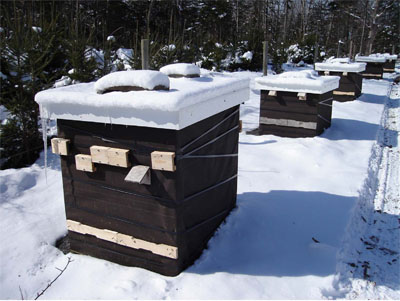 |
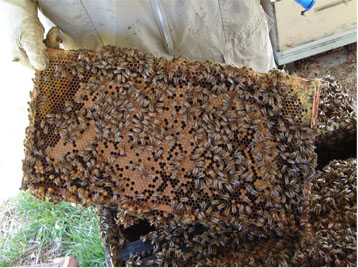 |
An early look at participating colonies and over-wintering sites, March 2008 |
Little and Williams completing detailed colony condition assessments, May 2008 |
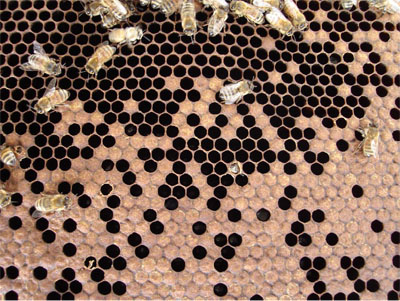 |
|
A promising sign: emerging new bees in spring, May 2008 |
|
Assessment of sublethal effects of Imidacloprid on honey bee and colony health
Galen P. Dively and Mike Embrey; Department of Entomology, University of Maryland
While the extent and causes of CCD are unknown, many believe that honey bees have reached a tipping point wherein the colony can no longer protect itself from a barrage of problems. The CCD Working Group developed an action plan of research that addresses four categories of factors that impact bee and colony health: 1) new or re-emerging pathogens; 2) bee pests; 3) environmental and nutritional stresses; and 4) pesticides. This project will address the latter category and examine the sublethal effects of pesticides, which is one of the priority areas identified by the HBHI Task Force for funding.
Nutritional effects on intestinal health and longevity of honey bee workers
Olav Rueppell; Department of Biology, University of North Carolina at Greensboro
This research project seeks to identify the effects of diet quality and malnutrition on the health of the honey bee worker intestine, as assessed by the activity of their intestinal stem cells. The intestinal epithelium is crucial to organismal health and it is one of the most exposed tissues in the animal body. Its cells are continuously replaced in a wide variety of organisms (Finch and Kirkwood 2000).
Although early reports on proliferative cells in the intestine of insects exist (Snodgrass 1956), these cells have only recently been characterized as bona-fide stem cells in adults through molecular analyses in Drosophila (Micchelli and Perrimon 2006; Ohlstein and Spradling 2006). A certain level of cell proliferation is necessary to maintain a functional intestine, even in the adult insect. Thus, the activity of these cells has been linked to insect growth (Hakim et al. 2007) and they are responsive to toxin exposure (Loeb et al. 2001; Gregorc et al. 2004). Furthermore, their rate of cell proliferation is positively correlated with food quality (Zudaire et al. 2004). Thus, the proliferative activity of intestinal stem cells may be an indicator of malnutrition with direct relevance to bee health.
Diagnostic gene panel for honey bee breeding and disease management
Jay D. Evans and Yanping Chen; USDA-ARS Bee Research Laboratory
Honey bees face numerous challenges, from nutritional stress to dedicated parasites and
pathogens. A long-term goal of bee research is to develop and maintain honey bee lines
that are resistant to disease, and that thrive with a minimum of chemical treatment of
disease agents. New molecular-genetic tools can aid research on breedable traits, and,
ultimately, these tools could be used directly by commercial bee breeders or others in the private sector. Beekeepers also rely on disease indicators and established thresholds while making management decisions. Such decisions could also be helped by genetic indicators for pests and for bee health.
This gene panel would differ from previous entries into disease forensics (e.g.,
Evans, 2006) by including only the most informative markers, alongside reportable
diseases found in bee colonies. In so doing, the panel can be cheaply applied to bee
problems, and can also be ‘exported’ to future technologies for bee diagnostics and genetic research.
The benefits of propolis to the immune system of honey bees
Marla Spivak; Department Entomology, University of Minnesota
We have initiated a comprehensive line of research in my lab on the benefits of propolis collection to the immune system of honey bees. Propolis is a resin secreted by some plants that honey bees collect and deposit in the nest. Propolis has important antimicrobial value to humans, but its value to the bees is not known. Here I am requesting funds to test if colonies selectively bred for high- and low-propolis collection differ in immune-related gene transcript levels. The applied goals of this research are to promote the natural immune defenses of honey bees and to promote the human use of propolis as an antimicrobial value-added product from the beehive.
Enabling genetic selection for resistance to viral pathogens: Developing a rapid and inexpensive cytometric method for screening honey bees for viral resistance
Dr. J. Spencer Johnston; Department of Entomology, Texas A&M University- Funded by Dr. Peter Swift, GDS Legacy Foundation and Reid and Margaret E. Dennis
Preliminary evidence suggests that honey bee strains are more resistant to IAPV than honey bee lines from other sources. We propose to use quantitative PCR, flow cytometry and direct monitoring of colony health to rapidly compare changes in blood cells number, pathogen titre and colony level response. We hypothesize that it will be possible to use flow cytometry to distinguish resistant bees from susceptible bees and evaluate the efficacy or extent of immune response to viral infection. If we are correct, then the results of the flow cytometry experiments could be used (in the place of more time consuming and expensive field trials) to quickly assess the presence or absence of viral resistance in aid of breeding programs to develop or propagate virus resistant honey bees. Perhaps more importantly, flow cytometry should reveal whether differential immune responses correlate with virus resistant phenotypes, offering clues to some mechanisms of viral resistance.
PODCAST: Click here to hear an recent update of Johnston's HBH Project
Changes in hormonal and protein levels in honey bees that are experiencing migratory transportation
Zachary Huang; Department of Entomology, Michigan State University
Aside from pesticides, perhaps the strongest stress honey bees experience comes from
long distance transportation, commonly used for pollination purposes. For example, bees can transported from Maine to California, across four different time zones. No studies have ever been conducted to determine the physiological or behavioral changes induced by such stress. In this study, I propose to piggyback with Dr. Jeff Pettis’s group to obtain data on physiological changes in honey bees that are experiencing migratory transportation. The objectives of this study is to 1) measure changes in juvenile hormones in bees that are being transported from Florida to California, and 2) determine the protein nutrition of the same bees. Proper control will be obtained from bees which are staying in Florida.
Update from 5/19/08: We are currently measuring the hormone levels in groups of bees in Bakersfield, CA and Boston, GA. We still have to thaw the bees and bleed them for the CA samples. We might do a third trial if we see something interesting.
Honey Bee Health Research Sponsors: Partnering for Bee Health
2008-2014 |
|
Click here to view the Colony Collapse Disorder public service announcement |
|
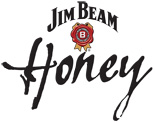 |
2013 |
 |
2009-2011 |
 |
2014 |
 |
2011 |